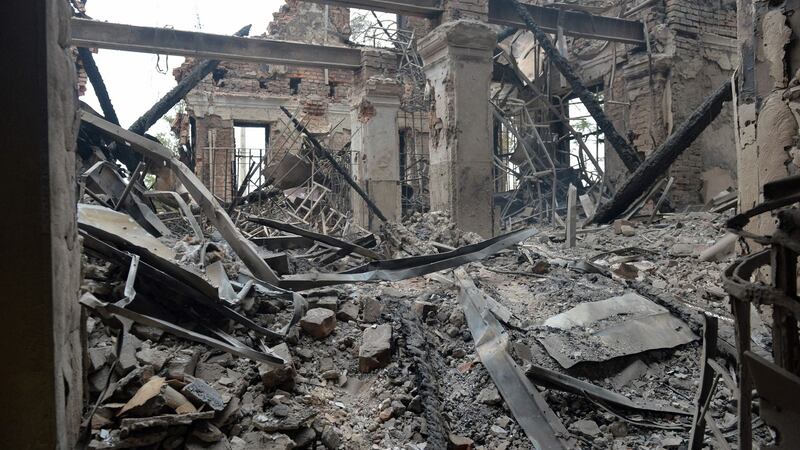The artillery barrage that Russia launched on Monday against the city of Kharkiv is a gruesome escalation of the tactics that Moscow has deployed in its five-day attack on Ukraine, and analysts warned it may only be a foretaste of worse to come.
Authorities in the eastern city said heavy shelling in residential areas had killed and wounded civilians. Televised footage shared widely on social media showed a barrage of strikes around apartment blocks, with multiple flashes of explosions and plumes of smoke rising from buildings.
“It’s a war, a real war,” Ihor Terekhov, Kharkiv’s mayor, told Ukrainska Pravda website.
Anton Gerashchenko, an adviser to Ukraine's interior minister, wrote in a Facebook post that "Kharkiv has just been massively fired upon by grads [rockets]. Dozens of dead and hundreds of wounded."
The onslaught came after Ukrainian troops repelled a Russian incursion into the city on Sunday and followed intensive exchanges on the city’s outskirts a day earlier, according to the UK defence ministry. Kharkiv, Ukraine’s second-largest city, is a key Russian military objective, along with the capital Kyiv.
A senior US defence official said Russia was trying to encircle Kharkiv, a city of 1.4 million inhabitants, and was using long-range fire in its efforts to take control there. “We do believe their plans are to encircle the city and to try to take it that way because that has really been where the heaviest fighting’s been,” said the official.
Pentagon officials said there were growing signs that Vladimir Putin’s forces were taking the same tack with Kyiv. Volodymyr Zelenskiy, Ukraine’s president, said on Monday that the country was braced for a crucial 24 hours, as Russian troops stepped up their efforts to encircle the capital.
“We’re starting to see the same sort of approach being applied to Kyiv,” said the official, adding that Russian forces had advanced about 5km over the past 24 hours and were now within 25km of the city centre.
The US official also said there were growing concerns that Russia’s frustration at the slow pace of its military assault on Ukraine could prompt it to use heavier bombing and missile attacks.

Escalation
Analysts said they feared that the escalation of force recalled the early stages of Russia’s levelling of Grozny in 1999. One of Putin’s first acts as president was a bombardment of the Chechen city as part of a war on Islamist separatists that left much of the city in ruins and killed up to 8,000 civilians.
"Today's pictures from Kharkiv certainly look like the beginnings of 'Groznification'," said Eliot Cohen, a professor at The Johns Hopkins University School of Advanced International Studies.
Despite Putin’s claims that he wanted to “liberate” Ukraine, Kharkiv lies in a Russian-speaking area of Ukraine, just 40km from the border. “Of course, Grozny was a Russian city too, but that didn’t stop Putin,” Cohen added.
In a sign of what may be to come, other videos shared on social media showed Russian SU-34 fighter-bombers flying over the city.
Olga, a Kharkiv resident who spoke to the Financial Times by phone, said she saw the rocket strikes while out buying groceries in the north-west of the city. The shelling intensified “and then the shrapnel started flying. We thought they shot a plane down”, she said. “It was deafening.”
Artillery
Analysts said the use of artillery barrages represents a Russian return to tried-and-tested military tactics after its advance in northern and eastern Ukraine bogged down after the failure of what Russian analysts described as an initial softly-softly approach.
“The instructions from the Kremlin were to reduce Ukrainian cities to rubble while liberating them,” said Pavel Felgenhauer, a Russian military expert.
But stronger than expected resistance incurred Russian casualties – as many as 4,500 according to Ukrainian authorities – and caused heavier than expected losses of tanks and other equipment. Russia has not provided a figure for the number of its personnel killed and injured.
Ukrainian and Russian military claims cannot be independently verified.
"Their attacking approach didn't play to Russian tactics in the beginning [OF THE WAR]so the obvious recourse is fall back to a strategy that does work," said Henry Boyd, a military expert at the International institute for Strategic Studies. "Kharkiv is already taking military barrages."
Analysts and officials have been warning that Russia’s setbacks, while spurring Ukrainian resistance, increased the chance of heavy bombardment and possibly assaults using thermobaric weapons, which use oxygen from the surrounding air to generate an intense, high-temperature explosion.
Social media posts on Monday also appeared to show TOS-1 heavy flame throwers positioned outside the besieged southern city of Mariupol. – Copyright The Financial Times Limited 2022











